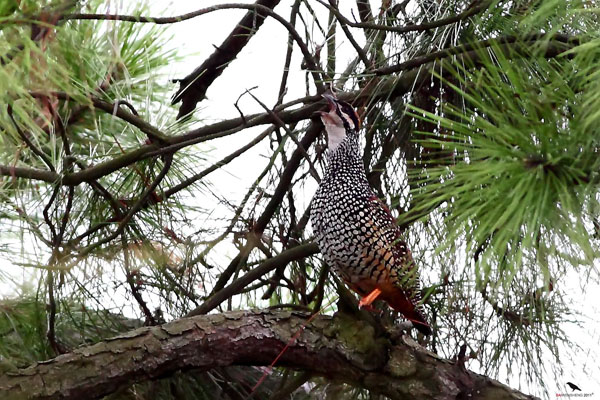Francolinus pintadeanus
IUCN
LCBasic Information
Scientific classification
- name:Francolinus pintadeanus
- Scientific Name:Chinese partridge, Yue pheasant, Huainan
- Outline:Landfowl
- Family:Galliformes Phasianidae Francolinus
Vital signs
- length:282-345 mm
- Weight:292-388 g
- lifetime:18 year
Feature
The timid Chinese partridge has excellent medicinal value
Distribution and Habitat
In China, it is distributed in the southeastern provinces and southwestern regions south of the Yangtze River and Hainan Island. Abroad, it is distributed in the Indochina Peninsula and extends to Indonesia.
It inhabits shrubs and grasslands in low mountain and hilly areas, and sometimes appears in farmland and bamboo forests. It often moves alone or in pairs.
Appearance
The Chinese Partridge is prettier than the Stone Partridge. It is black with white spots, has a dark brown head, chestnut eyebrow stripes, white cheeks and throat separated by black cheek stripes, chestnut shoulder feathers and undertail coverts. The female has a brownish-yellow base color. The iris is dark brown, the beak is black, and the feet are orange-yellow.
Details
Chinese partridges like to move in secondary forests, low shrub forests, and mixed wood forests. They especially like to live in environments with sparse trees covering the roof and few deciduous grasses below. They live in dry valleys between low mountains and on rocky and sandy slopes of hills. They live mostly in bushes, grasslands, barren mountains, and sometimes in small jungles and bamboo forests near farmlands. They are not on high mountains, not in forests, and rarely seen in open fields. They often forage in valleys in the early morning and dusk, spend the night in grass or bushes, and often change their roosting locations.
They like to move alone or in pairs, and are good at flocking like other chickens. They fly very fast and often fly in a straight line. They are extremely vigilant and always hide in grass or bushes, making them extremely difficult to find. Most of them fly to high places after being frightened, which is different from other chickens.

The Chinese partridge is omnivorous, mainly feeding on insects such as grasshoppers, locusts, crickets, ants, etc. It also eats various herbs, as well as the tender shoots, leaves, berries and seeds of shrubs, as well as grains such as grains, rice grains, peanuts, millet, and sweet potatoes, pinellia, locust fruit, rapeseed flowers, etc. scattered in the farmland.
The male bird also has a beautiful singing voice. Whenever spring comes and flowers bloom, under the morning light, male birds fly to high rocks or branches and sing loudly. Often, one bird sings loudly and a group of birds respond, one after another, all over the mountains and fields, bringing vitality to spring. They all have a very combative character and are also a species that is very strong in order to protect their nesting areas. Therefore, there is a saying in the origin of partridges: "There is a partridge on each hilltop, and they fight across the border."
Chinese partridge is a wild bird commonly eaten in the south. In the Ming Dynasty, Li Shizhen's "Compendium of Materia Medica" recorded: "Southerners specialize in moxibustion and eat it. They say that the meat is white and crispy inside, and the taste is better than chicken and pheasant." A proverb in Fujian: "Eat partridge meat in the mountains and eat mackerel (jiāo) (kuài) in the sea." It can be seen that the habit of eating partridges has long existed in southern China. In Guangzhou, after recovery, patients often stew partridges with Adenophora, bamboo shoots, wolfberries, and longan meat, which is said to have a nourishing effect. In Yongning, Chongzuo, Guiping, and Bobai in Guangxi, partridges are produced in large quantities. In Fujian, from the coast to the mountains in western Fujian, they can be found everywhere.
Partridge meat is rich in protein, fat, 18 essential amino acids, and high levels of trace elements such as zinc and strontium. It is rich in various vitamins and various minerals such as iron and potassium. It has the effects of strengthening yang, nourishing the kidneys, and strengthening the body. It is a nourishing product suitable for men, women, young and old.








